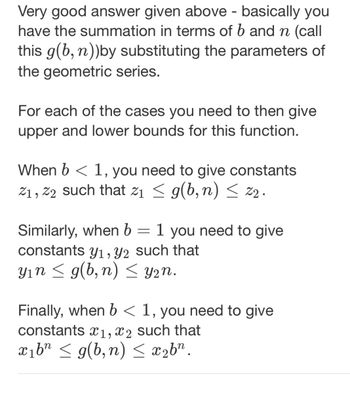
Advanced Engineering Mathematics
10th Edition
ISBN: 9780470458365
Author: Erwin Kreyszig
Publisher: Wiley, John & Sons, Incorporated
expand_more
expand_more
format_list_bulleted
Question
Solve the problem with short explanations following the hints(2nd image)

Transcribed Image Text:gn).
4. (Geometric Progression asymptotics) Let f(n) = 1 b² for some constant b>0. Then show that :
f(n)= (1) if b < 1
f(n) = O(n) if b = 1
f(n) = (bn) if b > 1
M
In order to solve this problem, it will be useful to recall that for a geometric progression with first term a and
common ratio r the sum of the first n terms is a(r"-1)
r-1
1:
-1.
f+L
£11
Lie

Transcribed Image Text:Very good answer given above - basically you
have the summation in terms of b and n (call
this g(b, n))by substituting the parameters of
the geometric series.
For each of the cases you need to then give
upper and lower bounds for this function.
When b < 1, you need to give constants
2₁, 22 such that 2₁ ≤ g(b, n) ≤ 22.
Similarly, when b = 1 you need to give
constants y₁, y2 such that
y₁n ≤ g(b,n) ≤ y₂n.
Finally, when b < 1, you need to give
constants x1, x2 such that
x₁bn ≤ g(b,n) ≤ x₂bn.
Expert Solution
This question has been solved!
Explore an expertly crafted, step-by-step solution for a thorough understanding of key concepts.
Step by stepSolved in 4 steps with 29 images

Knowledge Booster
Similar questions
- Answer the question in the format of the answer provided in the pic with tables. Do not answer the question with the tables beside itarrow_forwardA boy moves 4 miles south. Then he turns 90 degrees to the left. He moves forward 6 miles. He turns 90 degrees to the left. He moves forward 4 miles. How far is he now than from his starting point? (A) 4 miles (B) 3 miles (C) 6 miles (D) 5 milesarrow_forwardFind the angle between(-2,-3 ) and(-4,-6 ).arrow_forward
arrow_back_ios
arrow_forward_ios
Recommended textbooks for you
 Advanced Engineering MathematicsAdvanced MathISBN:9780470458365Author:Erwin KreyszigPublisher:Wiley, John & Sons, Incorporated
Advanced Engineering MathematicsAdvanced MathISBN:9780470458365Author:Erwin KreyszigPublisher:Wiley, John & Sons, Incorporated Numerical Methods for EngineersAdvanced MathISBN:9780073397924Author:Steven C. Chapra Dr., Raymond P. CanalePublisher:McGraw-Hill Education
Numerical Methods for EngineersAdvanced MathISBN:9780073397924Author:Steven C. Chapra Dr., Raymond P. CanalePublisher:McGraw-Hill Education Introductory Mathematics for Engineering Applicat...Advanced MathISBN:9781118141809Author:Nathan KlingbeilPublisher:WILEY
Introductory Mathematics for Engineering Applicat...Advanced MathISBN:9781118141809Author:Nathan KlingbeilPublisher:WILEY Mathematics For Machine TechnologyAdvanced MathISBN:9781337798310Author:Peterson, John.Publisher:Cengage Learning,
Mathematics For Machine TechnologyAdvanced MathISBN:9781337798310Author:Peterson, John.Publisher:Cengage Learning,


Advanced Engineering Mathematics
Advanced Math
ISBN:9780470458365
Author:Erwin Kreyszig
Publisher:Wiley, John & Sons, Incorporated

Numerical Methods for Engineers
Advanced Math
ISBN:9780073397924
Author:Steven C. Chapra Dr., Raymond P. Canale
Publisher:McGraw-Hill Education

Introductory Mathematics for Engineering Applicat...
Advanced Math
ISBN:9781118141809
Author:Nathan Klingbeil
Publisher:WILEY

Mathematics For Machine Technology
Advanced Math
ISBN:9781337798310
Author:Peterson, John.
Publisher:Cengage Learning,

